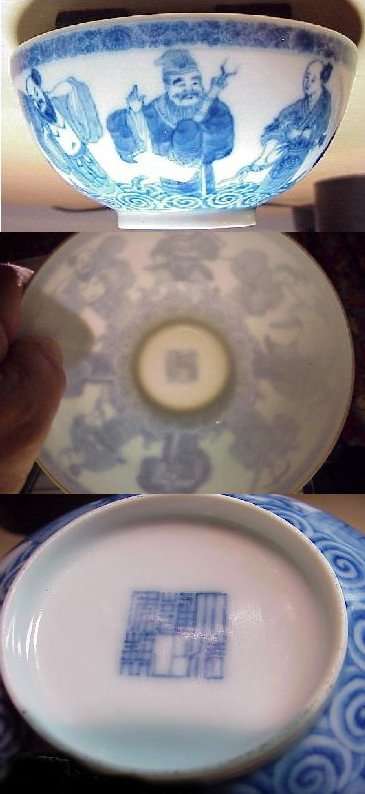
Chinese 'eggshell' porcleain.
Eggshell porcelain, also called danpi bodiless or tuotai bodiless ware, or Wade-Giles tan-p’i bodiless or t’o-t’ai bodiless ware.
Eggshell porcelain is characterized by an excessively thin body under the glaze. It often had decoration engraved on it before firing that, like a watermark in paper, that was visible only when held up to the light.
Decoration of this kind is called anhua, meaning literally 'secret language' regardless of the thickness of the body. Incised or impressed anhua decoration is not limited to eggshell porcelain but can occur on any white porcelains.
Eggshell porcelain was introduced in the Ming dynasty during the reign of the emperor Yongle (1402–24). It reappeared in the reign of the emperor Chenghua (1464–87), and later Yongle wares were copied under the emperor Wanli (1572–1620). Small vine cups with underglaze blue and white decoration was also found in the 'Hatcher' Ming cargo from Late Ming.
The paper-thin porcelain again occurred during the Qing dynasty (1644–1911/12), especially in the reign of the emperor Kangxi (1661–1722), in famille verte and famille rose porcelain, chiefly in bowls, plates, cups, and saucers. The manufacture of this porcelain takes skill since the thinness is arrived by manually trimming down the material in the unfired porcelain pieces with a steel knife.
First of all I must say that this bowl is a really good piece, especially if it like you say have underglaze blue decoration. I have thought a lot about several possibilities about a date but come to the conclusion that - based on what I can see of the pictures - it is rather modern. The oldest I can think of is the 1920's but the golden rim makes it possibly with a mid 50's date. They are still made like this today and I can't rule out anything regarding the date. All modern pieces must be judged on their own quality, which in this case is very good. The decoration is of the eight "Lohans". They were pupils of Buddha who by wisdom had gained immortality but chosen to stay on earth to help the human beings. I hope you are not too surprised by my opinion on the date, despite the Yongzheng mark. Eggshell thin pieces were actually made during the Yongzhen period. There were tea cups and saucers, and plates often with a "ruby back", but their bodies of the same thickness were less translucent. Porcelain of eggshell thinness - so called bodiless ware - is heard of as early as from the Yonglo period of the Ming dynasty. Eggshell thin Qingbai pieces were also made during the Song dynasty. I have seen a couple of these, and they are unbelievable thin, like paper. The production of modern eggshell porcelain started around 1916 during the period of Hongxian (1915-1916). In the planning of his official ware they settled for looking at the Yongzheng period as a model for the decoration after first having considered the Song dynasty. This is the most important reason for the revival of Famille rose enamel painting on porcelain at this time and a reason why the Yongzheng mark also speaks for the 1920's. During the 1920-30 eggshell ware became an important part of the total production program in Jingdezhen with well over 3300 men occupied by 1928. A serious break in production took place when the Japanese took Jingdezhen in 1937 after a surprise attack on Shanghai in 1932, the most important export harbor city. Eggshell thin porcelain is still made up to this day but most of it is decorated with enamels. Most of the less expensive pieces have their borders added with transfer prints and only the main decoration is hand painted. If your bowl is an early eggshell from the 1920's I can only congratulate, since these are very rare. Even if it's a later piece - even if it was made yesterday - it is still good since the decoration is underglaze blue. We can only imagine what kind of efforts it takes to decorate an unfired piece of porcelain of this thinness. The fragility and the tensions in the body of these piece have taken a great toll on what is still in existence today of the early pieces. So, go easy on your maid - these are really fragile pieces that might break in the heat of a spotlight in your own cabinet.A